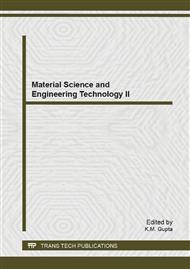p.48
p.53
p.60
p.64
p.69
p.74
p.79
p.87
p.92
Preparation and Characterization of Activated Carbons Based on Lignocellulosic Residues
Abstract:
This paper presents a comparative evaluation of three lignocellulosic residues (corn cobs, spent coffee grounds and Raphanus sativus press cake) as precursor materials in the production of activated carbons (ACs). Results indicate that the precursor material has a significant effect in both physical and chemical aspects of the adsorbent as well as on the adsorption mechanisms. Highest and lowest values of iodine number and density were observed for ACs based on press cake and corn cobs, respectively. Regardless of the observed differences in surface chemical make-up and adsorption mechanisms, all employed materials were deemed adequate for adsorbent production, since the prepared ACs presented adsorption capacities similar or even higher than those of commercial ACs and other residue-based adsorbents.
Info:
Periodical:
Pages:
69-73
Citation:
Online since:
December 2013
Keywords:
Price:
Сopyright:
© 2014 Trans Tech Publications Ltd. All Rights Reserved
Share:
Citation:


